Texas Railroad History - Tower 1 - Bowie
A Crossing of the Chicago, Rock Island
& Gulf Railway and the
Fort Worth & Denver City Railway
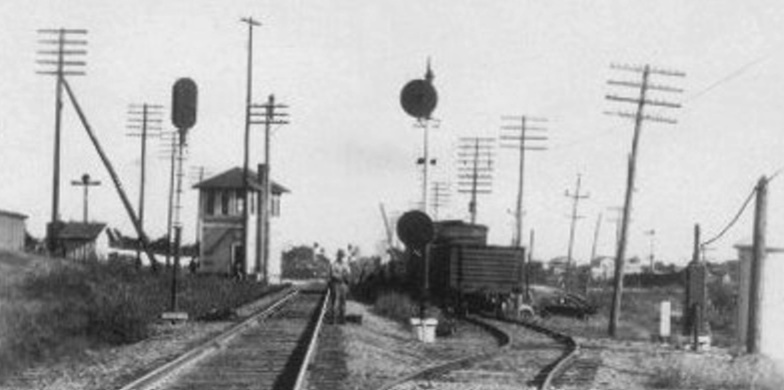 |
Left:
John Speake, a retired employee
of the Rock Island railroad born and raised "within one mile of the Bowie
tower", provides these historic
photos of Tower 1 and vicinity. John
comments...
This picture is at Bowie
Tower looking southbound standing on the FW&DC (Fort Worth & Denver City) tracks. The person
taking it would have had his back to Wichita Falls on the FW&DC. You can see the
north end of the 'short transfer' (interchange track) used by northbounds on FW&DC
and southbounds on the CRI&P (Chicago, Rock Island & Pacific.) Rail cars were much shorter at this time but I
expect it held 15-20 cars in it. |
Bowie was the site of a
construction camp for the Fort Worth and Denver City Railway (FW&DC, but
simply "FW&D" after 1951) as it built
north from Fort Worth toward Wichita Falls in 1882.
The small population in the area began to grow as new residents established
businesses to serve the railroad. Residents voted in 1884 to incorporate the
town, named for the famous
frontiersman James Bowie who was killed at the Alamo during Texas' War of Independence.
The town of Bowie quickly became the primary center of commerce between Fort Worth and
Wichita Falls, with rail connections to both cities on the FW&DC.
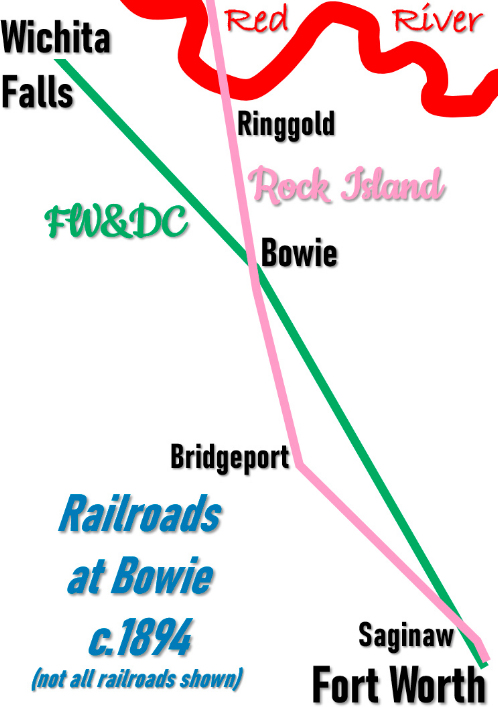 |
Left:
area map showing railroads through Bowie c.1894
In 1892, the
Chicago, Rock Island & Texas (CRI&T) Railway was chartered as a
Texas-based subsidiary of the Chicago, Rock Island & Pacific (CRI&P), a
major railroad serving the Midwest and Plains states. The CRI&T
was established for compliance with Texas' railroad ownership
laws with headquarters located at Bowie. The CRI&T would take title to tracks
that Rock Island would soon build in Texas as it built toward the Red River from El Reno,
Indian Territory. Rock Island bridged the river and crossed into Texas
near the community of Ringgold, ostensibly heading for Weatherford, 27
miles west of Fort Worth. From the river, the rails proceeded
generally south, crossing the FW&DC at Bowie in December, 1892 where the
two tracks
formed an acute X-pattern
rotated along a northwest / southeast heading. Service to Bowie commenced
January 22, 1893. From Bowie, the Rock Island
went south to
Bridgeport on a direct heading toward Weatherford, 32 miles beyond. But instead
of continuing to Weatherford, the CRI&T charter was amended in 1893 to
reroute the line to Fort Worth via Saginaw.
With two railroads, Bowie reached
2,600 population in the 1900 census.
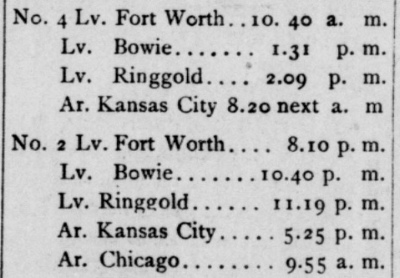
Left: By 1895, Rock Island was operating
"double daily fast express train service" through Bowie. This northbound
schedule printed in the Wise County
Messenger of May 17, 1895 shows Train #4 passing through
Bowie in the early afternoon and Train #2 passing through in late evening. Both
trains reached Kansas City the next day.
Bowie
was just another example of a common situation in Texas: tracks of two
railroad companies crossing at grade. State law required trains
approaching such crossings to stop before proceeding over the diamond,
causing a loss of physical momentum that
wasted fuel, water and time since
most often, the diamond was not occupied by another train.
A law passed by the Texas Legislature in 1901 granted the Railroad
Commission of Texas (RCT) authority
to regulate grade crossings of two or more railroads and to specify the
safety systems to be used -- typically interlocking plants with signals and derails
-- so that trains could proceed without stopping if there was no
conflicting movement on the other track. RCT was also given the authority to require
grade-separated crossings where appropriate. Bowie's crossing became the site of the first
commissioned interlocking plant in Texas,
but whether this was an intentional choice is undetermined. There were
numerous railroad grade crossings in Texas, so it may simply have
been the timing of when the railroads applied to RCT for authority to
install an interlocker.
To house the plant and its operators, the project erected a two-story building designated by RCT
as Tower 1. RCT would commission
215 numbered interlockers before the practice
ended in the mid 1960s. |
Right:
The
Austin Daily Statesman of April 18,
1902 reported that RCT had approved the tower and interlocking plant at Bowie. This was the first interlocker to be commissioned by RCT, but
it was not the first interlocking plant in Texas.
Tower A held that distinction having been installed by the railroads in Galveston in
1898 without RCT oversight. Tower A was placed under RCT's interlocker management
system in 1926.
The Tower 1 interlocker was a 26-function
mechanical plant, more than double the number of functions needed
for a simple crossing of two railroads (12). This indicates that the
plant
controlled additional signals, derails and switches associated with interchange tracks
between the two railroads. |
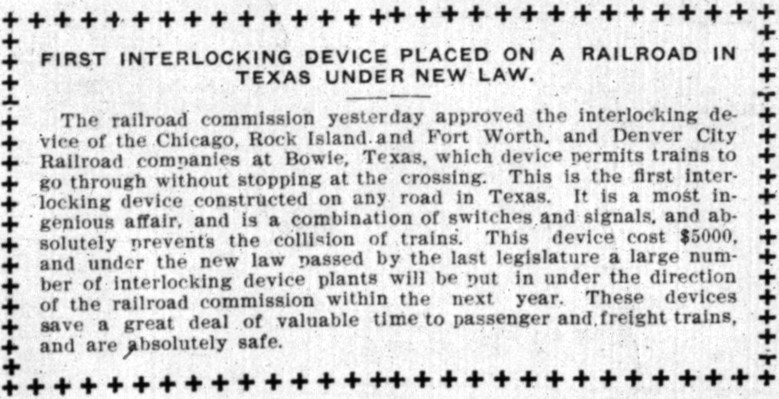 |
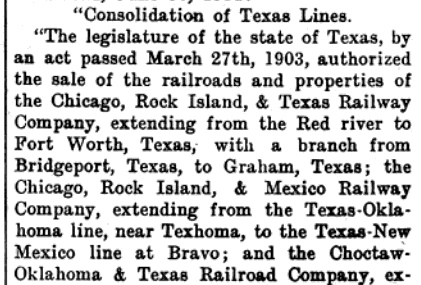 |
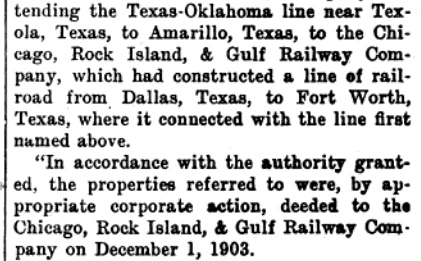 |
In a list of active interlockers
published by RCT on December, 31, 1903 (an annual practice RCT would continue
through the end of 1930), the two railroads identified with responsibility
for Tower 1 were the FW&DC and the Chicago, Rock
Island & Gulf (CRI&G) Railway. The CRI&T
no longer existed because earlier in 1903, it and two other Rock Island
subsidiaries in Texas had been absorbed into the CRI&G which Rock Island had chartered to build from Fort Worth to
Dallas.
Left: This excerpt from a 1921 U.S. Supreme
Court opinion explains how the CRI&G was created. The case involved a
lawsuit over the death of a Rock Island employee at Chickasha, Oklahoma. |
In 1916, RCT's
interlocker list began noting the railroad responsible for tower
operations. For Tower 1, it was the Rock Island, which most likely had taken the
lead in the design and construction of the tower, and the acquisition of its interlocking
plant. By law, the two railroads
split the capital cost of the tower and interlocking plant because the Bowie
crossing existed prior to the 1901 law that empowered RCT to regulate crossings
(different rules applied to crossings created after 1901.) The recurring
operating and maintenance expenses were shared between the two railroads, with
Rock Island billing the FW&DC on a periodic basis for its portion of the labor,
utilities and materials expenses required to operate and maintain Tower 1.
Today,
Bowie continues to see frequent trains. The
former FW&DC line is owned by Burlington Northern Santa
Fe (BNSF) and the former Rock Island line is owned by Union Pacific (UP).
John describes the
photos below...
Below Left...is a northbound Rock Island
train heading towards Waurika (Oklahoma) and points beyond. Notice the overhead
bridge of the old highway. You can see the interlocking rods from the tower to
the switch and signal running along the south side of the rail. The rear
of the train is near the north switch of the 'long transfer' (interchange
track.) Below Center
is the tower photographed from the south. I have no idea who is in the picture.
It clearly shows the steps in those days (early 20's) as being on the Waurika-El
Reno (north) side. When I was a child in the 40's, the steps up to the tower
were on the Fort Worth side. When the tower
burned, the steps were on the south side and came down along the
CRI&P
rail. The door you can see
would have been more or less under the steps.
The FW&DC is on the left and CRI&P is on the right.
Below Right
The person in this picture, which is dated August 1927, is a family friend who
has long since died. His name is A. Y. Holiday and he is sitting at the
telegraph desk in the tower. This desk was in the southeast corner of the tower
next to the FW&DC main on the Fort Worth
side.
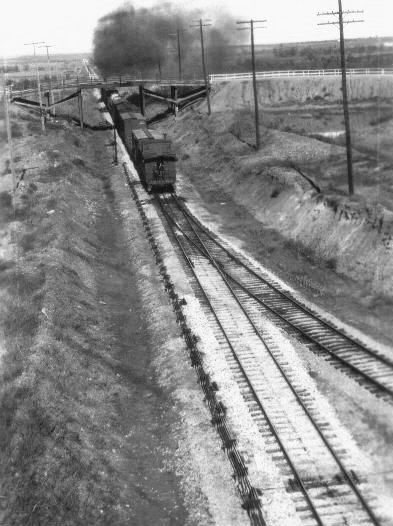
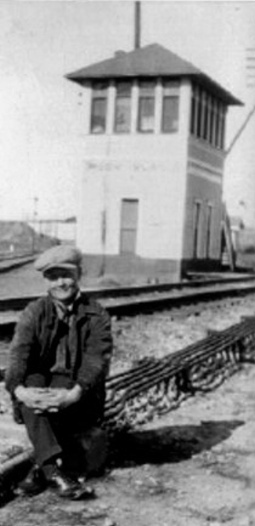

Historically, there were two transfer tracks between the railroads at Tower
1. The function count reported for Tower 1 in 1903 suggests that these transfer
tracks were in place by then and were controlled from the tower. The short transfer was southwest of the diamond and the
long transfer
was northeast of the diamond; neither exists today. Since the same two railroads
crossed at Saginaw, it is possible that a train could detour via the other
company's tracks if necessary to go around a derailment, a bridge outage, etc.
John does not recall ever seeing a through train use a transfer track, explaining...
I have no recollection of that
scenario happening. If a northbound Rock Island train had a car that was
destined for a location on the FW&D they would put it on the 'long transfer'. If
a southbound train (from Waurika) had a car with a destination on the FW&D then
it would go on the 'short transfer'. My father fed a milk cow at home. Someone
would ship a load of syrup in a tank car. It would end up on the transfer track
as a load. Some train would come by and take it to its destination for
unloading. A week or so later it would end up on the transfer but this time as
an empty car with no seal. Dad would get his trusty 5 gallon bucket out and put
it under the car spigot and drain the leftovers out of the car. When he got off
work he would bring it home and use it on the cow feed as a supplement and, yes,
it went on our hotcakes also.
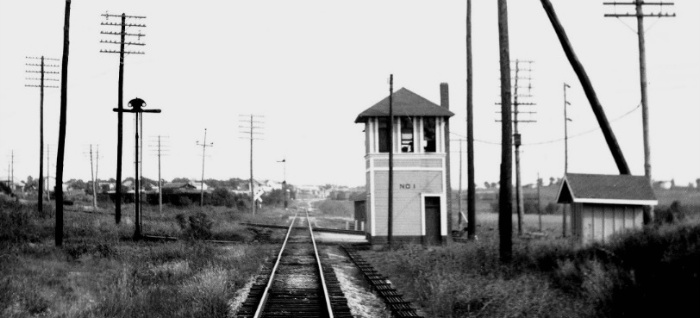

Above Left: John W Barriger
III took this photo of Tower 1 from the rear platform of his business car as he
passed northbound through Bowie in the 1930's. The view is to the south along
the Rock Island toward Fort Worth. The lettering on
the side of the tower simply says "No. 1". At some point, RCT may have adopted a standard
for displaying tower numbers using white rectangular placards with black
numerals, by far the most prevalent identification mark seen on towers for
which photographs exist. If such
standard existed, it may not have been applied to existing towers unless they were
rebuilt or substantially modified. (photo courtesy John W
Barriger III National Railroad Library) Above
Right:
The cabin for the automatic
interlocker that replaced the original plant is visible northwest of the diamond
in this photo from c.2000. It is facing the former Fort Worth and Denver tracks
that go to Wichita Falls to the left. The box mounted on the cabin to the left of the door may be the override controls that train crews could use to force the
interlocker to grant a signal if there was a malfunction. The cabin is no longer intact,
replaced by newer electronics in a larger cabin further from the diamond on the
opposite side of the BNSF tracks to the left. Straight ahead, UP's
former Rock Island line heads north toward Ringgold and the Red River. (Jim
King photo)
In August, 1950, Tower 1
burned to the ground. Rather than rebuild the tower, control of the crossing was
changed to an automatic interlocker, technology that had been approved for use
in Texas since 1930 (see Lubbock and Plainview.)
Right:
Under the lengthy title "Summaries of Applications Filed with
Interstate Commerce Commission for Approval of Extensive Changes or the
Installation of New Equipment", the
Signalman's Journal of May 1951 carried this news item
regarding the replacement of Tower 1. The installation of an automatic
interlocker at Bowie required extensive changes including removal of
"temporary stop signs on both roads", presumably installed on a swing
gate. In such cases, each train approaching the crossing was required to
do so at restricted speed so that it could make a complete stop if the
gate was determined to be positioned across the tracks. Otherwise, the
train was authorized to continue without stopping. If a full stop was
required, a crewmember would disembark and reposition the gate across
the other track, assuming no oncoming trains were visible. The relative
proximity of the crossing to a Rock Island maintenance facility may have
facilitated authorizing employees at Bowie to set the gate's position in
advance of a train's arrival based on knowledge of the schedules of both
railroads. |
 |
 |
Below is a series of
photographs taken during the cleanup of the fire and the installation of the new interlocker cabin. These photographs were provided by the
Rock Island Technical Society.


Above Left: A pile of rubble is all that remained of Tower 1 after
the
fire. The large metal hulk in the middle of the foundation is the interlocking plant. John Speake adds
"...you can see an old gas station back to the upper left. This station was at
one time on Highway 287 between the downtown area of Bowie and where the highway
crossed over both the CRI&P and FW&D tracks. We did not get much hard winter and
snows at Bowie but when we did, my father would take a bucket of coal to an
elderly lady that lived in this old station. She had no heat or electricity,
just a wood stove to cook on. She raised two or three children under these
conditions. Behind the signalman's shack you can see the 'long transfer' track
that provided interchange for southbound FW&D trains and northbound CRI&P
trains. As you can see, it hit the CRI&P main about 50 yards north of the tower
and the south end of this track hit the FW&D main about a quarter mile south of the tower
at MP 69."
Above
Right: The remains of Tower 1
are in the foreground, across from the section shed used for tools
and
materials
for the local maintenance-of-way gang. The small
shed to the right of the signal pole was used for motorcars
("speeders") for track inspection and maintenance. John Speake adds
that the photo also
"...shows a Coca-Cola
Bottling plant [right edge of photo] that also had a spur to it off the long
transfer. The building burned down
several years before my time (1940), but as a kid there were old Coke bottles in
the building melted with the heat,
and some bottles were still unbroken."


Above Left: A Rock Island steam crane (also known as a "big hook")
lifts the new automatic interlocker concrete
cabin from a gondola
car. Above Right: The new
cabin is carefully set in place just a few feet from the foundation of the
tower.


Above Left: After setting the new cabin, the big hook picks up the old interlocker
machine. Above Right: The old interlocker is lowered into the gondola ultimately to
find its way to a scrap yard.
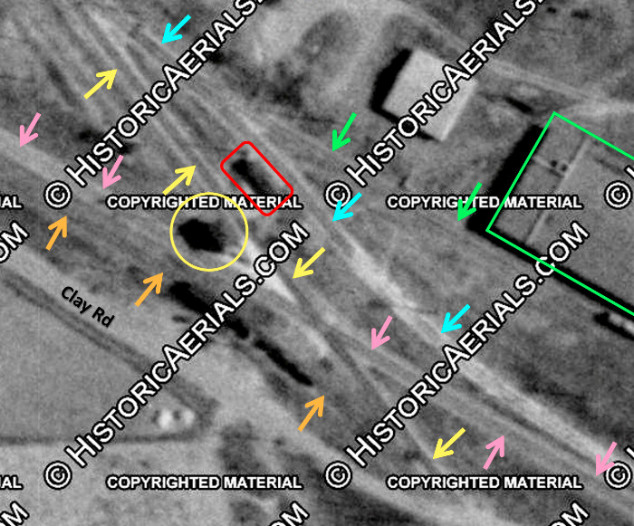

Above Left: This 1937 image ((c)historicaerials.com) has been annotated to show
the tracks and facilities at the Tower 1 crossing. The tower (yellow circle)
casts a shadow to the west along the FW&DC tracks (pink arrows.) Across the
Rock Island tracks (yellow arrows) from the tower sat what John referenced as
the "signalman's shack"
(red rectangle.) Behind the shack and to the right, the Coca-Cola bottling
facility (green outline) was served by a spur track (green arrows) coming off
the 'long transfer' (blue arrows.) The 'short transfer' (orange arrows) was
located on the opposite side of the diamond between the main tracks and Clay
Road, which still exists. Above Right:
This Google Street View from April, 2023 was taken from the Clay Rd. grade
crossing of UP's former Rock Island tracks. The view is northwest toward
Ringgold and UP's Red River bridge. The 'short transfer' came off a switch on
the Rock Island tracks behind the camera and passed to the left of the main line
near the orange post, curving around to the left to join the FW&DC tracks beyond
the recent-vintage silver equipment cabinet that houses the automatic
interlocker electronics. Tower 1 stood near the distant orange post in the acute
angle northwest of the diamond.
 |
Robert D. Speake was an operator at Tower 1. He is the father
of John Speake, the contributor of the above photographs to
the Rock Island Technical
Society. John adds... "He was leverman-operator at this tower from
the early 20's to the day it burned down." |





















